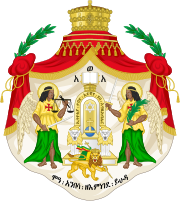Solomonic dynasty
The Solomonic dynasty is the name given by modern historians to the line of Ethiopian Orthodox Christian monarchs that ruled Ethiopia from the late 13th century to 1974.[1] Historian Harold G. Marcus describes the stories of the Kebra Nagast as a "pastiche of legends" created to legitimize Yekuno Amlak's seizure of power.In 1976, ten great-grandchildren of Haile Selassie were extracted from Ethiopia in an undertaking later detailed in a book by Jodie Collins, titled Code Word: Catherine.The elder Gondarine Amhara line, starting with Susenyos I in 1606 (although often credited to his son Fasilides who established his capital at Gondar) ended its rule with the fall of the largely powerless Yohannes III in 1855 and the coming to power of Tewodros II, whose later claims of Solomonic descent were never widely accepted.She married Dejazmach Yosedek, who gave rise to the Gojam Imperial House by means of their child "Talaku" Ras Hailu.[12] The Imperial coat of arms was adopted by Haile Selassie I, and is currently held by his direct heir in the male line, Prince Zera Yacob, and by the Crown Council of Ethiopia.[11] The phrase "Moa Ambassa ze imnegede Yehuda" (Conquering Lion of the Tribe of Judah) appeared on the arms, and always preceded the Emperor's official style and titles.The official Imperial Dynastic motto was "Ityopia tabetsih edewiha habe Igziabiher" (Ethiopia stretches her hands unto God), a quote from the Psalm 68:31.[citation needed][12] The full title of the Emperor of Ethiopia was Negusa Nagast and Seyoume Igziabeher (Ge'ez: ሥዩመ እግዚአብሔር; "Elect of God").Until the reign of Yohannes IV, the Emperor was also Neguse Tsion (Ge'ez: ንጉሠ ጽዮን, 'nəgusä tsiyon)', "King of Zion"), whose seat was at Axum, and which conferred hegemony over much of the north of the Empire (see: Ethiopian aristocratic and court titles).


Davidic lineEthiopian EmpireBete AmharaYekuno AmlakZera Yacob Amha SelassieHaile SelassieEmperor of EthiopiaKing of KingsQueen of KingsGondarineShewanZagwe dynastyMenelik IKing SolomonQueen of Shebaa coup d'étatHistory of EthiopiaEthiopian historiographyOrigin mythEthiopian Orthodox ChristianKingdom of AksumSolomonKebra NagastJerusalemDavid Northrup1955 Ethiopian constitutionMenelik IIZewdituLij IyasuEthiopian Revolutioncommunist régimeEthiopian HighlandsRed SeaGulf of AdenAmda Seyon IZara YaqobinvasionAhmad Gragncadet branchesSusenyos IFasilidesYohannes IIITewodros IIIyasu ITekle Giyorgis IIYohannes IVBattle of GallabatMahdistsMikael SehulMentewabBakaffaDawit IIPrince Zera YacobTekle Haymanot of GojjamTekle Haimanot, King of GojjamLeul Ras Hailu Tekle HaimanotEmblem of EthiopiaLion of JudahsymbolRastafari movementmonarchistsEthiopian nationalistsCrown Council of Ethiopiaglobus crucigerStar of DavidEthiopian tricolourEthiopian monarchist movementRastafariWesternAfrican diasporicreligious movementEthiopian aristocratic and court titlesThe Crown PrincePrincess IjigayehuPrincess Sifrash BizuPrince MakonnenPrince Joel Dawit MakonnenPrincess Ariana Austin MakonnenPrince Sahle SelassiePrincess Mahisente Habte MariamPrince Ermias Sahle SelassieThe Prince of TigrayLij Stefanos Mengesha SeyoumHaile Selassie IHoly Trinity CathedralAsfa-Wossen AsserateEthiopiapatriarchal crossList of emperors of EthiopiaOrder of SolomonOrder of Saint Mary of ZionRegnal lists of EthiopiaEmpiresAncientcoloniesAkkadianArmenianUrartuOrontidAssyrianMiddle AssyrianNeo-AssyrianBabylonianOld BabylonianKassiteNeo-BabylonianChineseEgyptianOld KingdomMiddle KingdomNew KingdomGoguryeoHarshaHellenisticSeleucidPtolemaicBactrianIndo-GreekHittiteHunnicXiongnuIranianMedianAchaemenidParthianSasanian